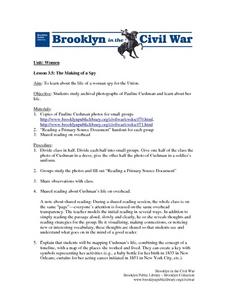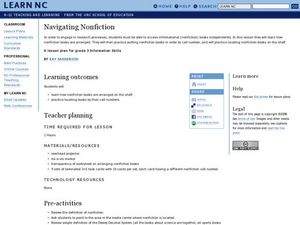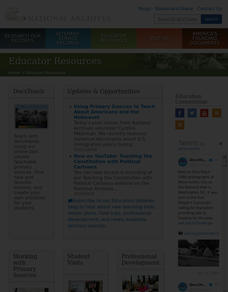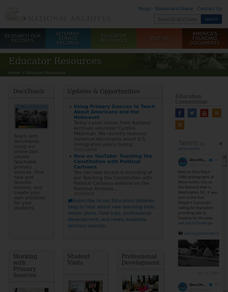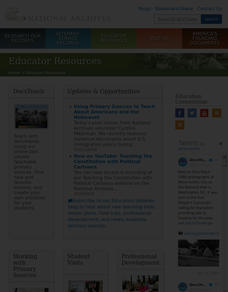National Park Service
News Bearly Fit to Print
There are an average of three human fatalities by bears in North America every year, which is low when you compare it to the 26 killed by dogs and the 90 killed by lightning annually. The lesson encourages researching human-bear...
Curated OER
Play Ball
Young scholars study the history of baseball in Brooklyn. They read a shared reading about the history of baseball in Brooklyn and respond to an archival picture of an early baseball game. They write two "teacher questions" for the class...
Curated OER
Biography -People Who Have Made A Change In Our Lives
Students create biographies about famous people. They use the library and the Internet to find pictures and information about the person they choose. They create a Kid Pix slide show and a poster.
PBS
1000 Words
A picture really can speak a thousand words—no matter how old! Scholars become history detectives as they learn how to analyze historical photos and evidence to uncover the past. The fun hands-on activity makes history come alive through...
University of California
Principles vs. Practices
Have you ever wondered what your own World Order would look like? Scholars use primary and secondary documents as well as video clips to investigate and analyze the Cold War. Using the sources, the principles and practices of nations...
Curated OER
Introduction of Primary Sources
First graders create two personal artifacts to add to a primary source shoebox that represents information about themselves. The first draw a self-portrait then build an artifact from Play-Doh and pipe cleaners to represent something...
Curated OER
Worksheet for Analysis of a Poster
In this primary source analysis worksheet, students respond to 25 short answer questions that require them to analyze the provided poster from the Tennessee State Library and Archives.
Curated OER
Earth's Radiation Budget
Twelfth graders explore the Earth's radiation budget using Earth radiation Budget Experiment (ERBE) data archived at the IRI/LDEO Climate Data Library. They use photometers and light sources to work through several hands-on activities...
Curated OER
Lead Stories about Confederation Lesson 5
Students identify what a lead story is and how to write one, for their simulated newspaper, about Confederation. They use primary-source documents from the "EvidenceWeb" portion of the Learning Centre, on the Library and Archives Canada...
Curated OER
The Making of a Spy
Young scholars study the life of a woman spy for the Union. They study archival photographs of Pauline Cushman and examine her life. They create a key with
symbols representing her activities (e.g., a baby bottle for her birth in 1833...
Curated OER
Navigating Nonfiction
Third graders explore the arrangement of nonfiction. For this library skills lesson, 3rd graders examine Dewey Decimal classification as they collaborate to locate nonfiction materials in the library/media center.
Curated OER
Fabulous Firsts in African American History
Learners study fascinating firsts and facts and answer questions about African American history. They demonstrate abilities to research information about African American history using Internet or library sources. Finally, they use the...
Curated OER
Kirit C. Shah, M.D. v. Stan Harris and Nancy Harris Lesson 1: One Case, Two Sides
Students examine how lawyers prepare their arguments. They realize that both sides of a legal case may use the same cases as precedents in their positions. They find decisions of the Indiana Supreme Court and the Indiana Court of Appeals...
Curated OER
Primary History: Children of World War II
In this World War II activity, students discuss the war with older people, and visit local libraries and museums to learn how the war changed the place where they live. They use resources to find out which countries were occupied and...
Curated OER
D-Day Message from General Eisenhower to General Marshall
Students use documents in the National Archives of the United States to evaluate the effectiveness of D-Day.
Curated OER
Cultural Inquiry Lesson 2B: Finding Artifacts and Analysis
Students build on their knowledge of sources, by looking at 2 types of information sources: artifacts or primary sources and analysis or secondary sources. They brainstorm a list of primary and secondary sources connected to one of...
Curated OER
Photographs of Lewis Hine: Documentation of Child Labor
Students use the Archival Research Catalog to complete assignments and activities about Lewis Hines and the National Child Labor Committee.
Curated OER
Sow the Seeds of Victory!
Students use the National Archives and Records Administration's records to research the history of the U.S. Food Administation.
Curated OER
Memorandum Regarding the
Students use the National Archives to research the memorandum regarding the enlistment of Navajo Indians during World War II.
Curated OER
Memorandum of a Conference with President Eisenhower after Sputnik
Students use the National Archives to research how the United States and the Soviet Union south to maintain its supremacy after World War II.
Curated OER
Court Documents Related to
Students use the National Archives to researcj cout coduments related to Martin Luther King, Jr.
Curated OER
Immigration and Settlement of Ethnic Groups in the Pacific Northwest
Learners examine ethnic history of the Pacific Northwest in the period 1850-1950. They research documents and images in digital archives to explore immigration of various ethnic groups that settled in the region during this period.
Curated OER
Possessive Nouns
Possessive nouns are intricately addressed in this detailed and colorful PowerPoint. Different rules about using possessive nouns correctly are defined with corresponding examples. You can use this presentation prior to assigning...
Curated OER
Autism - What Is It?
High schoolers investigate the symptoms of autism spectrum disorders, and compare expected child development with development that may indicate a diagnosis of these disorders. The final project for the lesson is the creation of posters...











